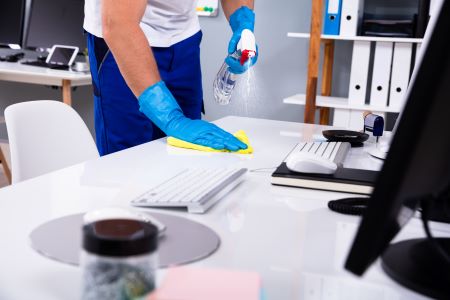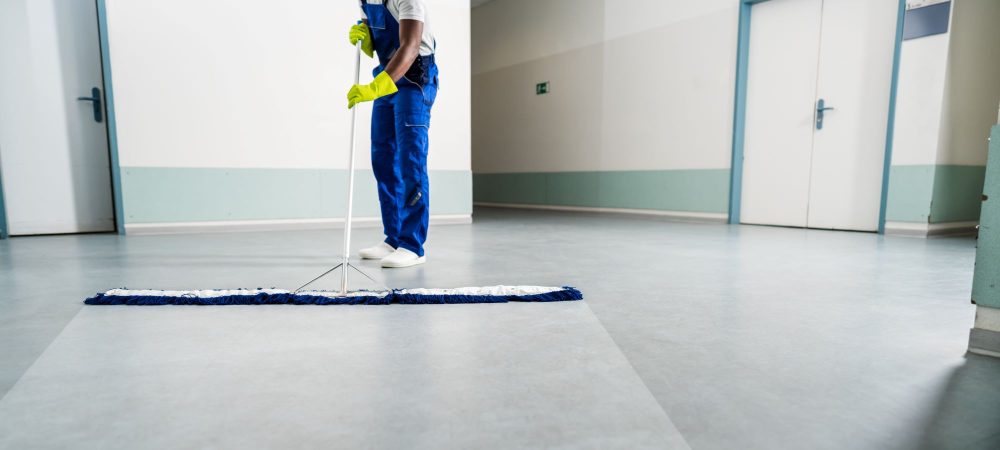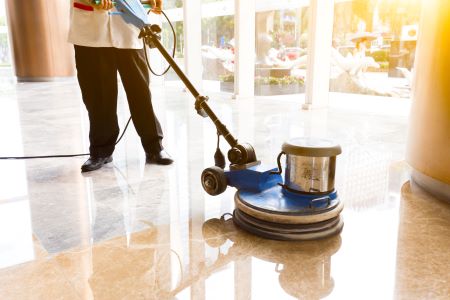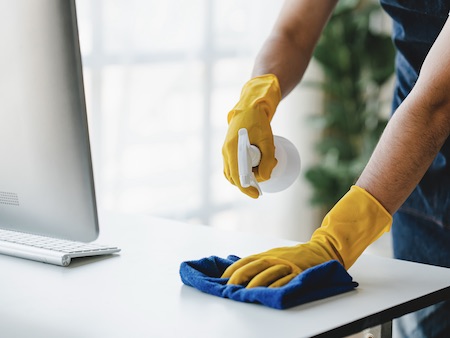Commercial space sanitization is crucial for Minneapolis businesses to enhance health, boost productivity, and ensure customer confidence.
Commercial space sanitization is an essential practice for businesses aiming to maintain a healthy and productive work environment. By implementing regular cleaning and disinfection procedures, companies can reduce the spread of germs and bacteria, leading to fewer sick days and improved employee morale. Here are some key benefits of commercial space sanitization:
- Reduces the spread of illnesses: Regular sanitization of commercial spaces helps to eliminate germs and bacteria, reducing the likelihood of employees getting sick.
- Boosts productivity: A clean and healthy work environment can lead to increased focus and productivity among employees.
- Improves air quality: Sanitization processes can also help to improve air quality by eliminating allergens and pollutants.
- Enhances reputation: A clean and well-maintained commercial space can enhance a company’s reputation and make a positive impression on clients and customers.
Table of Contents
Key Takeaways
- Commercial space sanitization is vital for Minneapolis businesses to maintain a healthy environment
- Proper sanitization reduces the spread of germs, bacteria, and viruses in workplaces
- Regular cleaning and disinfection of high-touch surfaces is essential
- Professional sanitization services use specialized equipment and EPA-approved disinfectants
- Implementing a comprehensive sanitization plan can improve employee productivity and customer confidence
Commercial space sanitization is a critical process for maintaining a clean and healthy environment in Minneapolis businesses. With the ongoing concerns about public health, proper sanitization has become more important than ever. This article will provide a comprehensive guide to commercial space sanitization, focusing on best practices, techniques, and benefits for businesses in the Twin Cities area.
Understanding Commercial Space Sanitization

Commercial space sanitization involves thoroughly cleaning and disinfecting all surfaces and areas within a business environment. This process goes beyond regular cleaning and aims to eliminate harmful microorganisms that can cause illness and disease.
The Difference Between Cleaning and Sanitizing
Many people use the terms cleaning and sanitizing interchangeably, but they are different processes:
- Cleaning: Removes visible dirt, debris, and some germs from surfaces
- Sanitizing: Reduces the number of bacteria and other microorganisms to safe levels
For effective commercial space sanitization, both cleaning and sanitizing must be performed regularly.
Why Sanitization Matters for Minneapolis Businesses
Minneapolis is home to a diverse range of businesses, from small startups to large corporations. Regardless of size or industry, all companies can benefit from proper sanitization practices. Here’s why it matters:
- Employee Health: A sanitized workspace reduces the risk of illness among employees, leading to fewer sick days and increased productivity.
- Customer Confidence: Visible sanitization efforts can help customers feel safe and comfortable in your business space.
- Legal Compliance: Many industries have specific sanitization requirements that must be met to operate legally.
- Reputation Management: A clean and sanitized space reflects positively on your business’s image and professionalism.
Key Areas for Commercial Space Sanitization
When sanitizing a commercial space in Minneapolis, it’s important to focus on high-touch areas and surfaces that are frequently used. These include:
Reception and Waiting Areas
The reception area is often the first point of contact for visitors and customers. Pay special attention to:
- Door handles and push plates
- Reception desk surfaces
- Chairs and armrests
- Pens and sign-in sheets
- Brochure racks and magazine holders
Office Spaces and Workstations
In open office layouts common in Minneapolis, sanitizing individual workstations is crucial:
- Keyboards and mice
- Desk phones
- Chair armrests and backs
- Drawer handles
- Personal items like staplers and tape dispensers
Meeting Rooms and Conference Areas
These shared spaces require frequent sanitization, especially between meetings:
- Table surfaces
- Chair arms and backs
- Remote controls for AV equipment
- Whiteboard markers and erasers
- Door handles
Break Rooms and Kitchens
Employee break areas can be hotspots for germ transmission:
- Refrigerator handles
- Microwave buttons and handles
- Coffee makers and water coolers
- Vending machine buttons
- Tables and chairs
Restrooms
Thorough sanitization of restrooms is essential for maintaining a healthy workplace:
- Toilet seats and flush handles
- Sink faucets and handles
- Soap dispensers
- Paper towel dispensers or hand dryers
- Door handles and locks
Effective Sanitization Techniques for Commercial Spaces

To ensure proper sanitization of your Minneapolis business, consider implementing these techniques:
Use EPA-Approved Disinfectants
The Environmental Protection Agency (EPA) maintains a list of approved disinfectants effective against various pathogens. Choose products that are appropriate for your specific needs and follow the manufacturer’s instructions for use.
Implement a Regular Cleaning Schedule
Develop a consistent cleaning and sanitization schedule tailored to your business’s needs. This may include daily, weekly, and monthly tasks to ensure all areas are properly maintained.
Train Employees on Proper Sanitization Procedures
Educate your staff on the importance of sanitization and teach them proper techniques for cleaning and disinfecting their work areas.
Invest in Professional Sanitization Services
Consider hiring a professional commercial cleaning service in Minneapolis that specializes in sanitization. These experts have access to industrial-grade equipment and products that can provide a deeper level of sanitization.
The Role of Technology in Commercial Space Sanitization

Advancements in technology have introduced new tools and methods for sanitizing commercial spaces:
Electrostatic Sprayers
These devices apply an electric charge to disinfectant solutions, allowing them to wrap around and coat surfaces more effectively.
UV-C Light Disinfection
Ultraviolet-C light can be used to sanitize surfaces and air in commercial spaces, particularly in healthcare settings.
HEPA Air Purifiers
High-efficiency particulate air (HEPA) filters can help remove airborne contaminants, improving overall air quality in your business.
Creating a Sanitization Plan for Your Minneapolis Business

Developing a comprehensive sanitization plan is essential for maintaining a healthy commercial space:
- Assess your business’s specific needs and high-traffic areas
- Choose appropriate cleaning products and tools
- Establish a cleaning schedule and assign responsibilities
- Train employees on proper sanitization techniques
- Regularly review and update your plan as needed
The Impact of Sanitization on Employee Productivity
A clean and sanitized workspace can have a significant positive impact on employee productivity:
| Factor | Impact on Productivity |
|---|---|
| Reduced Sick Days | Up to 20% fewer absences |
| Improved Focus | 5-10% increase in concentration |
| Enhanced Morale | 15% boost in job satisfaction |
| Fewer Distractions | 8% reduction in time wasted |
The Cost of Neglecting Commercial Space Sanitization
Failing to properly sanitize your commercial space can lead to various negative consequences:
| Consequence | Potential Cost |
|---|---|
| Employee Illness | $1,500-$2,500 per employee per year |
| Customer Loss | Up to 30% decrease in repeat business |
| Legal Issues | Fines up to $7,000 for OSHA violations |
| Reputation Damage | 22% of customers won’t return after one bad experience |
Sanitization Best Practices for Different Industries

While the basic principles of sanitization apply to all businesses, some industries require special attention:
Healthcare Facilities
- Use hospital-grade disinfectants
- Follow strict protocols for handling biohazardous materials
- Implement regular deep cleaning of all patient areas
Restaurants and Food Service
- Sanitize food preparation surfaces frequently
- Clean and disinfect dining areas between customers
- Pay special attention to high-touch items like menus and condiment containers
Retail Stores
- Regularly sanitize checkout counters and point-of-sale systems
- Clean and disinfect fitting rooms between uses
- Implement a system for sanitizing returned or tried-on items
Office Buildings
- Focus on shared spaces like elevators and lobbies
- Provide sanitization stations throughout the building
- Encourage regular cleaning of personal workspaces
Maintaining Long-Term Sanitization Efforts
Sustaining a sanitized commercial space requires ongoing effort and commitment:
- Regularly review and update your sanitization plan
- Stay informed about new sanitization technologies and best practices
- Conduct periodic deep cleaning in addition to regular maintenance
- Encourage employee feedback on sanitization efforts
- Consider seasonal adjustments to your sanitization routine
The Future of Commercial Space Sanitization in Minneapolis

As businesses in Minneapolis continue to adapt to changing health concerns, the future of commercial space sanitization looks promising:
- Increased adoption of touchless technologies
- Greater emphasis on air quality and ventilation
- Integration of sanitization practices into building design
- Development of more eco-friendly and sustainable sanitization products
Prioritizing Health Through Sanitization
Commercial space sanitization is an essential aspect of running a successful and responsible business in Minneapolis. By implementing thorough sanitization practices, businesses can protect the health of their employees and customers, maintain a positive reputation, and contribute to the overall well-being of the community. As we move forward, the importance of maintaining clean and sanitized commercial spaces will only continue to grow, making it a wise investment for businesses of all sizes and industries. For more information, you can visit our website or contact us.

